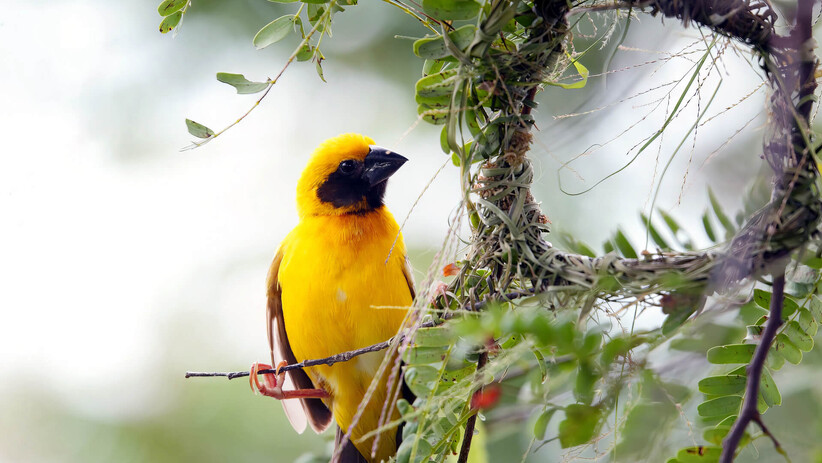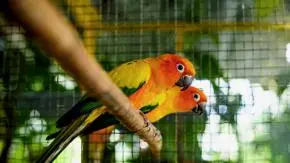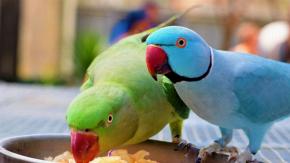The moment your beloved pet bird escapes through an open door or window, your heart sinks. Seeing your feathered friend fly away is a gut-wrenching experience, but swift action is crucial.
Panic is your worst enemy; remain calm and focused. Remember, lost birds often stay within close proximity, so there’s a good chance your bird is nearby.
escaped-bird-recovery-plan.jpg
This guide will outline the steps to take immediately after your bird escapes, including conducting a thorough search of the immediate vicinity, setting up a familiar cage with food and water, and alerting local businesses, animal shelters, and bird groups.
Let’s bring your bird home safely.
1. Secure the Area
When your beloved pet bird’s cage is empty, securing the area is crucial to prevent your missing bird from flying away. Confining the lost bird to a specific space increases the chances of a successful reunion.
Start by closing all windows and doors in the immediate vicinity, as an open window invites your bird to fly further.
Enlist the help of family members or neighbours to cover more ground and maintain visual contact with your bird if it’s sitting in a nearby tree or on the ground.
More eyes searching for your bird means you’re more likely to spot your lost budgie or parrot. If the bird enters your house, close the door to contain it.
Keep its cage nearby, as the familiar sight might lure it back. If you’ve lost sight of your feathered friend, try calling it using familiar sounds and have your favourite food ready.
Stay calm to avoid scaring it.
2. Locate Your Bird
When your beloved pet bird goes missing, it’s natural to worry.
To locate your lost bird, it’s important to understand the common behaviours of escaped birds. They often perch on nearby trees, rooftops, or utility lines, so use binoculars to scan these areas thoroughly.
Listen for your bird’s distinctive calls or vocalisations, especially during quiet times of the day.

If you spot your bird, avoid sudden movements that might scare it. Instead, try to lure it back with food or familiar sounds. If your bird is still learning to fly, it might not have gone far. Search a five-house radius, paying attention to bushes and low branches.
Leave your bird’s cage outside with the door open, filled with favourite treats.
Hopefully, your bird will fly back inside. If you have an aviary, place your other parrots inside, as their calls may attract your missing bird.
Alert local animal control, pet stores, and vets, providing a detailed description and contact info.
If you have a small cage, bring it with you and ask other bird owners if they’ve seen your feathered friend. Don’t give up hope – many lost birds are reunited with their loving owners.
3. Entice Your Bird with Familiar Items
If your beloved pet bird has gone missing, don’t lose hope just yet. You can entice your lost bird to return home by using familiar items. Start by setting up a “recovery station” near the exact location where your feathered friend flew away.
This will increase the chances of your bird spotting familiar objects and being drawn back to safety.
To create an influential recovery station, place your bird’s cage in a visible and accessible spot.
Ensure the cage door is open and fill it with your pet’s favourite toys and treats. The sight and scent of these items will comfort your lost bird and encourage them to approach the area.
Consider adding a water bowl nearby, as your bird may be thirsty after being out in the wild.
If possible, hang some of your bird’s preferred treats or toys on nearby branches to catch their attention.
Another helpful technique is to play recordings of your bird’s vocalisations or even your voice.
The familiar sounds may prompt your pet to investigate further, leading them back to the recovery station.
It’s crucial to keep a watchful eye on the area, as your bird may be cautious about approaching if other birds or humans are around. Once your feathered friend is safely inside the cage, close the door to prevent them from flying away again.
4. Approach Your Bird Calmly
When attempting to approach your bird, it’s crucial to remain calm and move slowly.
Sudden movements or loud noises can startle your feathered friend, causing them to fly away or injure their flight feathers.
Birds are sensitive animals, and a frightened bird may be more difficult to recover if it’s flown to another part of the yard or home.

To safely coax your bird back, gently extend your finger, hand, or a perch, and use a soft, reassuring voice. Avoid making direct eye contact, as this may be perceived as a threat.
If your bird seems afraid or resistant, carefully use a towel or net to recover them. However, be cautious and gentle; you don’t want to damage their delicate flight feathers or cause further distress.
Remember, escaping is a natural instinct for birds when they feel threatened. As a responsible bird owner, creating a safe, secure environment is essential to minimise the chances of your bird flying away.
By understanding your bird’s behaviour and needs, you can build a trusting relationship with your feathered companion, making it easier to approach them calmly should the need arise.
5. Prevent Future Escapes
Preventing future escapes is crucial for ensuring the safety and well-being of your feathered companion.
To effectively address this issue, it is essential to identify and tackle the underlying cause of the escape.
This may involve carefully examining your bird’s living area for potential escape routes, such as gaps in cages or unsecured windows. Take the time to thoroughly inspect and reinforce these areas to prevent your bird from exploiting any weaknesses.
In addition to securing the bird’s primary living space, consider designating a specific “bird-proof” room for supervised out-of-cage time.
This room should be free of hazards and have secure windows and doors to minimise escape risk.
Plus, investing time in training your bird to respond to specific commands or cues can be invaluable in the event of an escape. Teaching your bird to return to you on command or to a designated perch can make the recovery process much easier and less stressful for you and your feathered friend.
Consistency and positive reinforcement during training sessions will help strengthen your bond and establish a reliable recall system.
5. Don’t Give Up: Persistence Pays Off

Don’t give up hope if your beloved bird has flown the coop. Persistence pays off when searching for an escaped feathered friend. Even if you don’t spot your bird immediately, keep looking and spreading the word.
There are many inspiring stories of birds being found safe days or weeks after flying away, thanks to their determined owners never giving up the search. Birds are resilient and resourceful.
Stay calm, stay focused, and keep the faith.
Post flyers, search dawn and dusk, when birds are most active, and follow up on leads. Your persistence will be rewarded when you and your bird are reunited.
Safeguarding Your Feathered Friend’s Future
Preventing bird escapes is crucial, but being prepared for potential breakouts and acting quickly can make all the difference in a successful recovery. Always have a plan, and don’t hesitate to act if your feathered friend goes missing.
Remember, persistence is key. Following the steps outlined and refusing to give up significantly increases the chances of reuniting with your beloved bird.
Stay focused, enlist help, and keep searching until your feathered companion is safely back home.
Planet Pet offers a wide range of bird supplies designed to keep your pet secure, enriched, and content.
Explore our collection for top-quality cages, harnesses, and bird toys, prioritising your bird’s safety and well-being.
If you need expert advice or have questions about preventing escapes, our knowledgeable team at Planet Pet is here to help. Contact us anytime for guidance and recommendations on the best products to ensure your bird remains safe and happy in their forever home.
Together, we can create a world where every bird is cherished, protected, and never far from a loving embrace.






